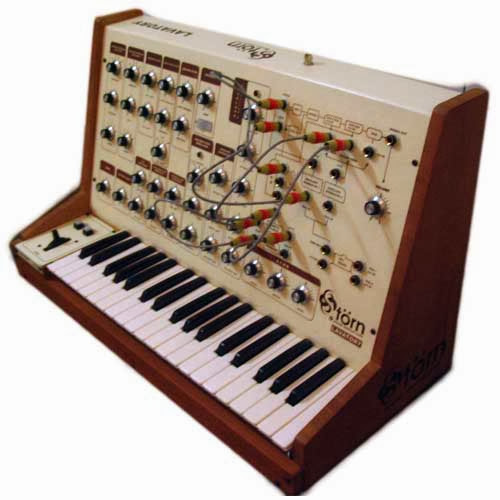YouTube Uploaded by jeanielotsacats on Sep 9, 2011
"This is a demo of the Synergy II+ synthesizer. Based on the Bell Labs Digital Synthesizer created by Hall Alles in 1975, the Synergy II+ remains one of the rarest and most sophisticated digital synthesizers in music history. There are only a few dozen of these left in working condition today."
via this auction
Additional video at the auction and below.
"DKI SYNERGY II+ SYNTHESIZER WITH KAYPRO 2X
VOICE PROGRAMMER, SYNHCS 3.22 SOFTWARE,
COMPLETE SYNERGY VOICE LIBRARY AND MANUALS
In 1978, the synthesizer manufacture Crumar licensed the design of the Bell Labs digital synthesizer. They hired another engineer, Stoney Stockell, to turn Alles' collection of IEEE-696 circuit boards in a minicomputer chassis into a commercial digital synthesizer with a built-in keyboard and front knobs. (The original Bell Labs digital synthesizer had 4 joysticks, 10 buttons and 16 sliders, but no other controls. It didn't even have a synthesizer keyboard. Researchers had to wire up an external organ keyboard to the RS-422 lab interface to communicate with it.)
With 32 digital oscillators and 2 sixteen-point frequency and amplitude envelopes for each oscillator, the Synergy digital synthesizer had 128 envelopes total, with 16 points each. No other synthesizer had ever used such a complex architecture. There were too many oscillators and envelope points even to be controlled by the dozens of buttons and knobs on the Synergy's front panel, so an external computer was used. To voice the synthesizer, a Kaypro 2 computer got connected to the Synergy via RS232 serial interface, and Crumar programmers wrote a Z80 assembly language program for the Kaypro 2.
When Crumar licensed the Bell Labs digital synthesizer, they changed their name to DKI (Digital Keyboards Incorporated). The DKI Synergy synthesizer originally sold for $3500, not including the Kaypro 2 computer -- that added another $1795. Attached to the Synergy by an RS232 serial port, the optional Kaypro 2 came with SYNHCS: the Synergy Host Control System. This was the program that let the user program the Synergy's staggeringly sophisticated digital synthesis architecture and create and store user-defined synthesis architectures on Kaypro floppy disk. The SYNHCS program has many different pages that let the user define the number of oscillators and the shape of the max and min envelopes, set the oscillator architecture, set up aperiodic vibrato and envelope loop points, define the A and B digital filters, edit voice banks, set up real-time perofrmance presets for the Synergy II+ synthesizer and store Synergy timbres and real-time performance banks on Kaypro floppy discs.
The Synergy came in two models: the Synergy I, with 24 sounds in ROM and no MIDI and no user programmability, and the Synergy II+, which added a modification board inside the synthesizer to allow MIDI in and out and full programmability and user storage of new timbres by means of the Kaypro 2 computer.
DKI originally hoped that users would buy the Synergy and then keep on buying Synergy ROM cartridges, like customers buying one razor and many razor blades. Wendy Carlos signed on to create timbres for the Synergy, and eventually 22 different banks of 24 voices were created for the Synergy, for a total of 524 Synergy timbres. These timbres ran the full gamut from spacey digital sounds to chimes and gongs, to ethnic instruments like drums and xylophones and membranophones, to plucked and struck sounds, to brass and woodwinds, and rich strings and subtle keyboard timbres like the celesta and the vibraphone and the electric piano.
The Synergy doesn't sound like any other synthesizer. It's warm and vibrant. It sounds alive. This is party due to the unprecedented sophistication of the synthesizer envelopes, which interpolate between 16-point max and min values depending on how hard each synthesizer key gets pressed on the keyboard. In part it's due to the interaction of the A filters and B filters with the digital oscillators, since each digital filter gets defined for each separate oscillator. And in part the unique sound of the Synergy results from the synthesizer's aperiodic vibrato, which add user-controlled unpredictability to the amplitude and frequency envelopes of each oscillators, just like a real acoustic instrument, where each note on a violin or each note on a flute sounds slightly different.
All the timbres on this YouTube video were created using the Synergy with multitrack tape. This video shows SYNHCS running on the Kaypro 2x and sending the Wendy Carlos voice bank number 1 to the Synergy:" [video above]




























































